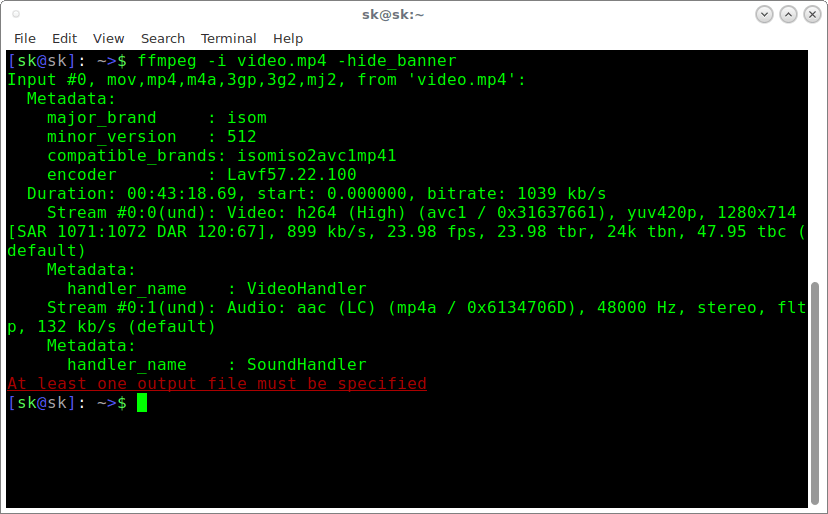
input ( 'pipe:', format = 'rawvideo', pix_fmt = 'rgb24', s = ' '. run_async ( pipe_stdout = True ) ) process2 = ( ffmpeg. output ( 'pipe:', format = 'rawvideo', pix_fmt = 'rgb24' ). Quiet – shorthand for setting capture_stdout andĪ subprocess Popen object representing the child process. Pipe_stderr – if True, connect pipe to subprocess stderr. Pipe_stdout – if True, connect pipe to subprocess stdout (to be

Pipe_stdin – if True, connect pipe to subprocess stdin (to be run_async ( stream_spec, cmd='ffmpeg', pipe_stdin=False, pipe_stdout=False, pipe_stderr=False, quiet=False, overwrite_output=False ) ¶Īsynchronously invoke ffmpeg for the supplied node graph. Returns: (out, err) tuple containing captured stdout and stderr data. **kwargs – keyword-arguments passed to get_args() (e.g. Input – text to be sent to stdin (to be used with pipe: Quiet – shorthand for setting capture_stdout and capture_stderr. ParametersĬapture_stdout – if True, capture stdout (to be used withĬapture_stderr – if True, capture stderr. Invoke ffmpeg for the supplied node graph. run ( stream_spec, cmd='ffmpeg', capture_stdout=False, capture_stderr=False, input=None, quiet=False, overwrite_output=False ) ¶ get_args ( stream_spec, overwrite_output=False ) ¶īuild command-line arguments to be passed to ffmpeg. Error ( cmd, stdout, stderr ) ¶īases: Exception ffmpeg. Includes the ffmpeg command as the first argument. This is the same as calling get_args() except that it also The run() function uses this to build the commnad lineĪrguments and should work in most cases, but calling this functionĭirectly is useful for debugging or if you need to invoke ffmpeg

compile ( stream_spec, cmd='ffmpeg', overwrite_output=False ) ¶ The stderr output can be retrieved by accessing the Raisesįfmpeg.Error – if ffprobe returns a non-zero exit code,Īn Error is returned with a generic error message. Run ffprobe on the specified file and return a JSON representation of the output. probe ( filename, cmd='ffprobe', **kwargs ) ¶ Official documentation: Main options ffmpeg. Overwrite output files without asking (ffmpeg -y option) To tell ffmpeg to write to stdout, use pipe: as the filename. If multiple streams are provided, they are mapped to the same audio_bitrate=200.įormat – alias for -f parameter, e.g. video_bitrate=1000.Īudio_bitrate – parameter for -b:a, e.g. Some keyword-arguments are handled specially, as shown below. output ( *streams_and_filename, **kwargs ) ¶įfmpeg.output(stream1, filename, **ffmpeg_args)Īny supplied keyword arguments are passed to ffmpeg verbatim (e.g. Include all given outputs in one ffmpeg command line ffmpeg. To tell ffmpeg to read from stdin, use pipe: as the filename. input ( filename, **kwargs ) ¶Īny supplied kwargs are passed to ffmpeg verbatim (e.g. output ( audio, video, 'out.mp4' ) view ( detail=False, filename=None, pipe=False, **kwargs ) ¶ ffmpeg. More information about this library can be found at the FFmpeg website.Input = ffmpeg. The source is the unmodified FFmpeg source from the release/2.8 branch, commit hash 913c642c21. The exact commit hash is 650671b908.īuilds of TouchDesigner099 2016.4160 and earlier edit The source is the modified FFmpeg source from the release/3.1 branch. The exact commit hash is bb950df5e.īuilds of TouchDesigner099 2016.4180 up to 2018.29999 edit The source is the modified FFmpeg source from the release/4.0 branch.
#What is ffmpeg used for series#
The exact commit hash is 26b7a17f8f.īuilds of TouchDesigner099 2018.40000 series edit The branch is release/4.3.Derivative.īuilds of TouchDesigner099 2019.100.20000 series edit The source is the modified FFmpeg source from the release/4.3 branch.
#What is ffmpeg used for code#
Source Code edit Builds of TouchDesigner 2020.40000 series and later edit Usage of FFmpeg is granted by the LGPL version 3 license, available for viewing here, as well as in the Samples\OSSLicenses folder in TouchDesigner's installation directory.

2.1 Builds of TouchDesigner 2020.40000 series and later.


 0 kommentar(er)
0 kommentar(er)
